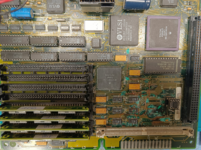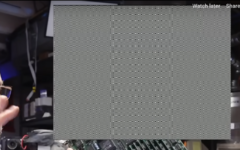ironborn65
Well-known member
I’m currently working on a heavily damaged Macintosh SE/30. The original post on the repair process can be found here: Salvaging bombed SE/30.
I've restored continuity in the address lines between the RAM multiplexer (MUX), ROM SIMM, VROM, and CPU, and verified the data lines from the ROM SIMM to both the VROM and CPU. The acid damage affected the area surrounding the RAM MUX and the RTC, which I have since replaced with an ATTiny85.
The caps were replaced but there were no signs of corrosion or leaks.
The board was washed, rinsed, soaked and rinsed in IPA.
After confirming that there were no shorts on the power rails or in the newly added bodges, I powered up the system using a verified working PSU extension cable. Sadly, the machine remains silent.
The RAM is populated with four 1MB SIMMs of 60ns RAM in the first bank. The ROM is the original, stock version, and continuity from the SIMM to the ROM chip on the PCB has been verified to avoid contact issues, even if the socket is the one with the metal clips. All major chips are warming up, indicating they are receiving power. Pressing the reset button triggers a faint “tick” from the speaker.
The +5V lines measure approximately 4.9V.
I observed that pin 1 (CK) on the UG7 clock generator shows a sinusoidal waveform at 14.7 MHz and around +2V, while I expected a square wave. Is this right?
Pins 2 through 8 display square waves as expected.
Could you advise on additional checks or diagnostic steps I should take?"
I've restored continuity in the address lines between the RAM multiplexer (MUX), ROM SIMM, VROM, and CPU, and verified the data lines from the ROM SIMM to both the VROM and CPU. The acid damage affected the area surrounding the RAM MUX and the RTC, which I have since replaced with an ATTiny85.
The caps were replaced but there were no signs of corrosion or leaks.
The board was washed, rinsed, soaked and rinsed in IPA.
After confirming that there were no shorts on the power rails or in the newly added bodges, I powered up the system using a verified working PSU extension cable. Sadly, the machine remains silent.
The RAM is populated with four 1MB SIMMs of 60ns RAM in the first bank. The ROM is the original, stock version, and continuity from the SIMM to the ROM chip on the PCB has been verified to avoid contact issues, even if the socket is the one with the metal clips. All major chips are warming up, indicating they are receiving power. Pressing the reset button triggers a faint “tick” from the speaker.
The +5V lines measure approximately 4.9V.
I observed that pin 1 (CK) on the UG7 clock generator shows a sinusoidal waveform at 14.7 MHz and around +2V, while I expected a square wave. Is this right?
Pins 2 through 8 display square waves as expected.
Could you advise on additional checks or diagnostic steps I should take?"


